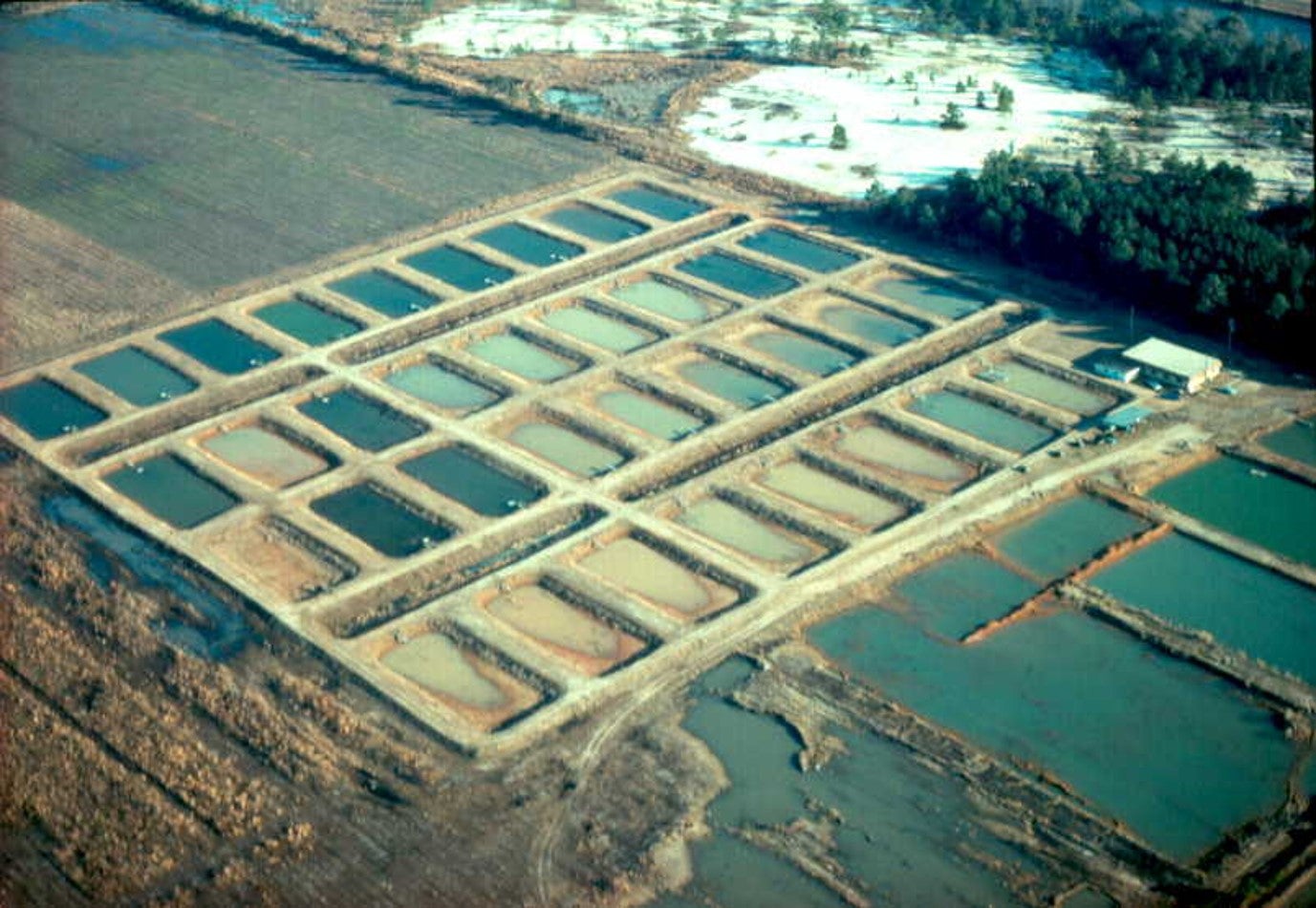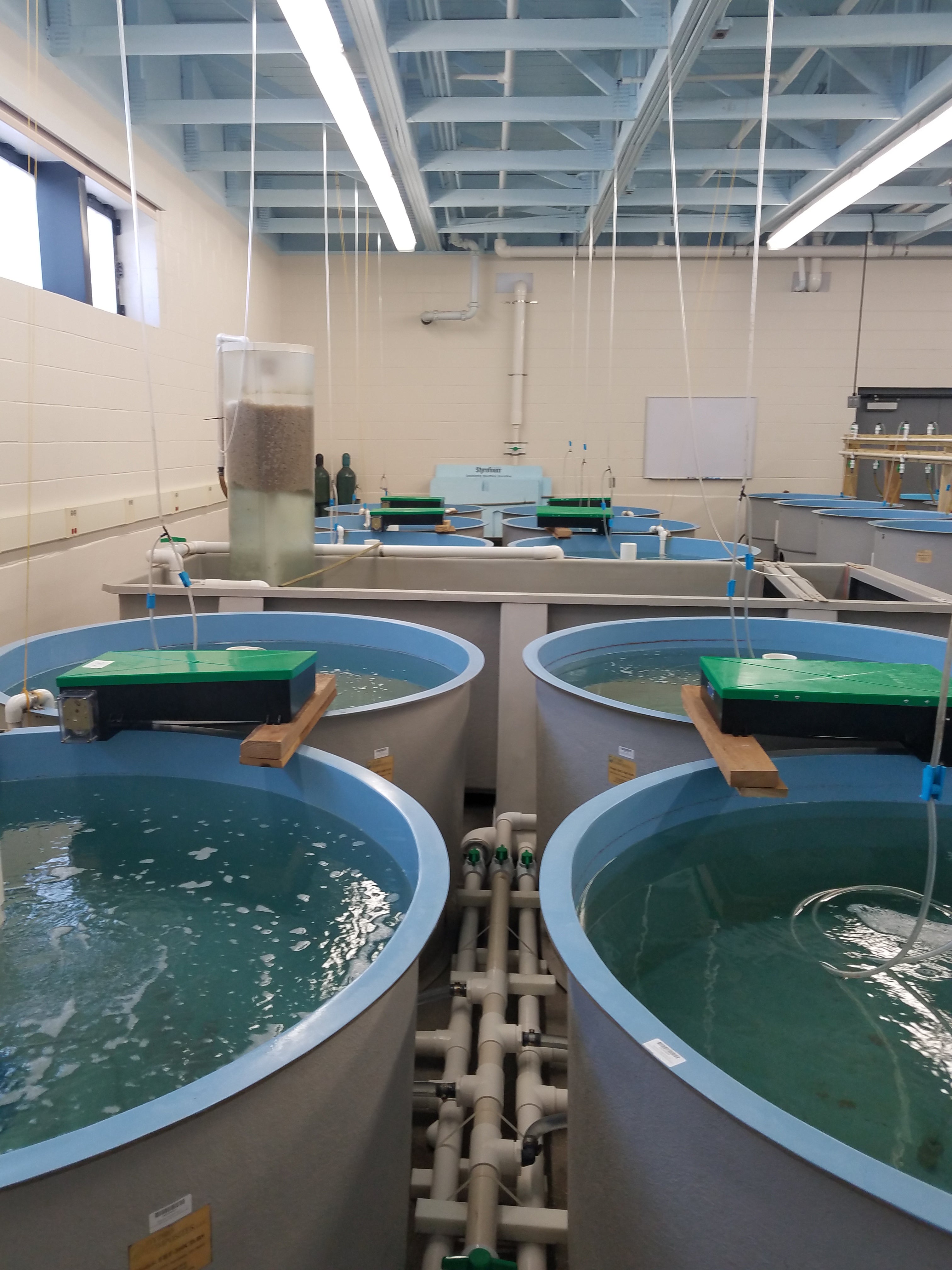The Alabama Marine Resources Division (AMRD) maintains the Claude Peteet Mariculture Center (CPMC) located in Gulf Shores, Alabama. CPMC was created in 1970 when 40 acres of land were donated to the State by Ms. Mildred Casey. An additional 5 acres was purchased by the State which provided access to the Intracoastal Waterway and a brackish water source needed to fill ponds. By 1973, thirty-five (35) 0.2-acre ponds and a small pump station located on the intracoastal waterway were installed on the property. A small hatchery building used for broodstock holding and egg fertilization and hatching was completed in 1975. From 1970 through the early 1980s the infrastructure and operational costs of CPMC were primarily funded with federal grants related to the culture and stocking of Gulf of America strain striped bass (Morone saxatilis) in Alabama waters.

Aerial View of CPMC circa 1980

Aerial View of CPMC circa 1990

Aerial View of CPMC circa 1999

Aerial View of CPMC circa 2013
During the mid-1980s through the mid-2000s, a variety of species were cultured at CPMC including spotted seatrout (Cynoscion nebulosus), red drum (Sciaenops ocellatus), Eastern oysters (Crassostrea virginica) and red snapper (Lutjanus campechanus). During this period the ponds were lined with high density polyethylene to prevent seepage and greenhouse structures with tanks and recirculating water systems were completed. Beginning in the mid-2000s, shrimp and Florida pompano (Trachinotus carolinus) were the primary species cultured at CPMC. A saltwater supply line which begins at the Gulf State Park Pier was installed in 2004 but the intake was destroyed by hurricane Ivan. The intake was not replaced until 2009.

Red Snapper Strip Spawning circa Late 1990s
In July 2013, a new 23,000 square foot hatchery building was completed replacing the old hatchery building. The new building provides a significant upgrade in fish production capacity. It contains areas for broodfish spawning, algae production, live food production, egg incubation, larval rearing, and juvenile holding. The hatchery also includes a greenhouse complex containing several re-circulating tank systems.
Currently, three species of fish popular among Alabama saltwater anglers are cultured at CPMC including Spotted Seatrout (Cynoscion nebulosus), Florida Pompano (Trachinotus carolinus), and Southern Flounder (Paralichthys lethostigma). Southern flounder broodstock were collected in 2018; however, due to a protracted acclimation period documented by other southern flounder researchers spawning is not anticipated by CPMC staff until early 2020. Although most fish reared at CPMC are primarily for stock enhancement purposes, some fish may be tagged prior to release to assist with determining growth rates and movement patterns.

Juvenile Florida Pompano Raised at CPMC
Fish Culture Method:
Broodstock (parent fish) are collected from local waters and relocated to maturation tanks within the hatchery. Collected fish undergo temperature and photoperiod manipulation within the maturation tanks to mimic natural conditions and stimulate spawning activity. Broodstock will spawn on their own within the maturation tanks or be removed from the tanks and strip spawned, the technique of manually removing eggs and milt (sperm) which are combined to initiate fertilization. Fertilized eggs collected from egg collectors built into each broodstock tank or from mixing containers used during strip spawning are counted using a volumetric method and distributed among hatching jars/tanks. Eggs hatch within a 36-48-hour period and larval fish are counted by sampling a portion of the water column. From this point, larvae will either be stocked into ponds or remain in within the hatchery.
Tank Culture:
Conditions affecting growth and survival are maintained much more easily in a tank system; however, labor and operational costs needed to maintain fish in an indoor culture system are greater than a pond system. Larval fish are maintained in a temperature-controlled re-circulating system using full strength seawater (salinity greater than 30 ppt). Twenty-four hour care is provided for larval fish in a tank culture system soon after the eggs hatch. Once eggs hatch, the hatchlings are considered yolk-sac larvae. At this point, they have no mouths or eyes, but will develop them over the next 36-48 hours. Once fish develop their eyes, they need to eat immediately. From here, the fish need to be moved from hatching containers to the larval rearing systems for further grow out.
Larval fish cultured at CPMC require live foods for the first 14-16 days after hatching. The fish require a certain size of food particle that can be captured and ingested. Two types of zooplankton are used to feed the young larval fish. Rotifers are used as a first food for the first 8-10 days after hatching. Brine shrimp (Artemia spp.) is used as a second live food. As fish continue to grow, they require larger sized prey items, thus the need to change food sources. Larvae are weened onto brine shrimp Artemia spp. starting around 8 days after hatching. At the same time, larval fish are also introduced to a formulated feed. Fish will be completely weened to an artificial diet by approximately day 16 after hatching.
For red drum and Florida pompano, the culture period is approximately 35-45 days to grow to a 1-2-inch fingerling. Southern flounder require approximately 60-75 days to grow to a 1-2-inch fingerling. At 1-2-inches the fish are of ideal size for harvesting and transporting to the release site. Once fish reach the appropriate size and after a sample of each group of fish pass inspection for common diseases, they are released in coastal Alabama waters.

CPMC Tank Culture Facilities
Pond Culture:
For extensive systems, ponds are utilized, and less care is required. Prior to a spawning event, ponds are filled with brackish water, then fertilized with both organic and inorganic fertilizers to establish a phytoplankton bloom. This phytoplankton bloom is the food source for the zooplankton in the water. As the phytoplankton blooms, the zooplankton populations will increase and “bloom” as well. These zooplankton are the food source for newly hatched fish.
Once fish develop and eye, they are transferred to the ponds for further grow out. During the transfer process, fish are acclimated to pond temperature and salinity. Fish will grow on the natural foods in the ponds for approximately 20 days. After that time, a crumbled, pelleted feed will be provided for the rest of the culture period. The culture period lasts approximately 45-60 days after which fish will be 1-2 inches in length. Once fish are of size and after a sample of each group of fish pass inspection for common diseases, they are harvested from the ponds and released in Alabama waters.
In recent years, the operations and maintenance of CPMC has been funded through the Fish and Wildlife’s Sport Fish Restoration Program and your fishing license purchases. Thank you!

CPMC Pond Culture Facilities
Baldwin County (red drum and southern flounder):
- Wolf Bay
- Barber Marina
- Little Lagoon
- Moe’s Landing boat ramp
- Weeks Bay and Fish River
- Pelican Point and Weeks Bay boat ramp
- Bon Secour River
- Aquila and Plash Island boat ramp
- Bon Secour Bay
- The Pines boat ramp
- Magnolia River
- Nolte Creek boat ramp
- Intracoastal Water Way
- Canal Park boat ramp
- Roberts Bayou
- Josephine Park boat ramp
- Cotton Bayou and Bayou St. John
- Boggy Point boat ramp
Fish Release Sites
Mobile County (red drum and southern flounder):
- North Mobile Bay
- Chocolatta Bay boat ramp
- West Fowl River
- Delta Port boat ramp
- Dog River
- River Shack boat ramp
- Heron Bay
- Jemison’s Bait -N- Tackle
Baldwin and Mobile County (Florida pompano):
- Orange Beach
- Boggy Point boat ramp
- Fort Morgan
- Fort Morgan boat ramp

Fish Release Sites
For more information, contact Max Westendorf.





